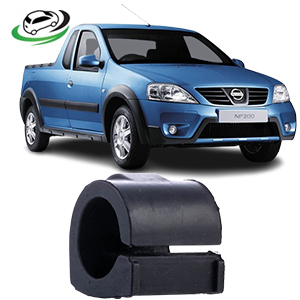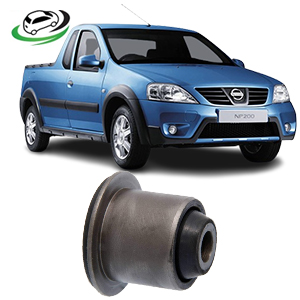-17%
Get Nissan Pick Up NP200 Front Lower Arm Bushing Assy 26304
The Front Lower Arm Bushing Assembly, commonly referred to as the front control arm bushing, is an essential component of a vehicle’s suspension system. It serves as a flexible link between the chassis and the control arm, allowing the suspension to move while absorbing road shocks, vibrations, and minimizing noise. The bushing helps maintain proper alignment of the front wheels, ensuring smooth handling and ride comfort. Though small in size, the front lower arm bushing assembly plays a crucial role in the overall stability and performance of the vehicle.
In this detailed explanation, we will explore the structure, function, types, importance, maintenance, and signs of failure of the Front Lower Arm Bushing Assembly.
Structure of the Front Lower Arm Bushing Assembly
The front lower arm bushing assembly consists of several key components designed to work together to provide flexibility, support, and cushioning to the suspension system:
- Outer Metal Shell: This is a durable steel or aluminum casing that encases the bushing, providing the necessary rigidity to securely connect the control arm to the vehicle’s chassis.
- Inner Sleeve: The inner sleeve is a metal tube that is located inside the bushing. The control arm passes through this sleeve, and it allows controlled rotational movement of the arm relative to the chassis.
- Rubber or Polyurethane Material: Sandwiched between the inner sleeve and the outer metal shell is a layer of flexible material, typically rubber or polyurethane. This material absorbs road shocks, dampens vibrations, and allows limited movement of the suspension components.
- Bonding or Press-Fit Design: The rubber or polyurethane layer is either bonded to the metal sleeves or designed to be press-fitted. This ensures that the bushing is tightly held in place within the control arm and chassis.
- Flexible and Durable Design: The bushing is designed to flex slightly during suspension movement, allowing the control arm to pivot without transferring too much vibration or harshness to the vehicle’s body.
Function of the Front Lower Arm Bushing Assembly
The primary role of the front lower arm bushing assembly is to provide a cushioned and flexible connection between the front lower control arm and the vehicle’s chassis. This allows for controlled movement of the suspension while reducing the impact of road imperfections. Key functions of the front lower arm bushing assembly include:
- Damping Vibrations and Shocks: The bushing absorbs much of the road-induced vibrations and shocks, preventing these forces from being transmitted to the vehicle’s chassis and cabin. The rubber or polyurethane material in the bushing acts as a buffer, improving ride comfort.
- Maintaining Proper Wheel Alignment: The bushing helps keep the control arm in its correct position, maintaining the alignment of the front wheels. This ensures stable handling, better traction, and prevents uneven tire wear.
- Allowing Controlled Suspension Movement: The bushing allows the control arm to move slightly in response to changes in road conditions, such as bumps, dips, and turns. This controlled movement is crucial for absorbing road shocks and preventing excessive stress on the suspension components.
- Reducing Noise: By cushioning the connection between the control arm and the chassis, the bushing helps reduce noise generated by suspension movement. Without the bushing, metal-to-metal contact would cause loud clunks or rattles when driving over rough terrain.
- Improving Handling and Stability: The bushing helps control the movement of the suspension, ensuring that the wheels remain aligned with the road surface. This contributes to improved vehicle handling, especially during cornering or when driving over uneven surfaces.
- Reducing Wear on Other Suspension Components: By absorbing vibrations and controlling movement, the bushing helps reduce the strain on other suspension components, such as the control arms, ball joints, and shocks. This contributes to the longevity of the entire suspension system.
Types of Front Lower Arm Bushings
There are several types of front lower arm bushings, each with unique characteristics and applications. The material and design of the bushing can greatly affect the performance, durability, and comfort of the suspension system:
- Rubber Bushings: Rubber bushings are the most common type found in most passenger vehicles. They are flexible and provide excellent vibration damping, making them ideal for everyday driving. However, rubber bushings can degrade over time due to exposure to heat, chemicals, and road debris.
- Polyurethane Bushings: Polyurethane bushings are stiffer and more durable than rubber bushings. They are often used in performance or off-road vehicles where enhanced handling and durability are required. While polyurethane bushings offer better responsiveness, they may transmit more noise and vibration to the cabin than rubber bushings.
- Hydraulic Bushings: Some modern vehicles use hydraulic bushings, which contain a fluid-filled chamber that enhances vibration absorption. These bushings provide a smoother ride and are often used in luxury or high-performance vehicles. Hydraulic bushings are more expensive but offer superior comfort and noise reduction.
- Solid or Spherical Bushings: Solid or spherical bushings are typically used in high-performance or racing applications. These bushings eliminate most of the flex associated with rubber or polyurethane, providing extremely precise handling. However, they do not offer the same level of comfort and are generally not suitable for daily driving.
- Adjustable Bushings: In some high-performance vehicles, adjustable bushings are used to allow fine-tuning of the suspension system. These bushings enable drivers to adjust the alignment or suspension geometry for specific driving conditions or track performance.
Importance of Front Lower Arm Bushings
The front lower arm bushing assembly is vital for the overall performance, comfort, and safety of the vehicle. Its importance can be broken down into several key aspects:
- Improved Ride Comfort: By absorbing shocks and vibrations, the front lower arm bushing assembly ensures a smoother and more comfortable ride. Passengers experience less jarring from road imperfections, making long drives more enjoyable.
- Better Handling and Stability: Properly functioning bushings help maintain the alignment of the front wheels, contributing to better handling and stability. This is especially important when cornering or driving on rough roads, as the bushing helps keep the suspension under control.
- Enhanced Suspension Longevity: The bushing acts as a buffer between the control arm and the chassis, reducing wear on other suspension components. By preventing excessive movement and vibrations, the bushing helps extend the life of the suspension system.
- Increased Safety: The bushing helps maintain the stability of the vehicle by ensuring that the control arm functions properly. Worn or damaged bushings can lead to poor handling, increased body roll, and reduced control, increasing the risk of accidents.
- Reduced Noise and Vibration: By cushioning the connection between the control arm and the chassis, the bushing helps reduce noise and vibration, providing a quieter and more pleasant driving experience.
Maintenance of Front Lower Arm Bushings
Regular maintenance of the front lower arm bushing assembly is essential for ensuring optimal suspension performance and preventing premature wear. Key maintenance tips include:
- Routine Inspection: Inspect the bushings for signs of wear, cracking, or deterioration during routine vehicle maintenance. Rubber bushings, in particular, can dry out and crack over time, especially in extreme climates or rough driving conditions.
- Check for Noise or Vibrations: If you notice clunking, rattling, or increased vibrations in the cabin, it may indicate that the front lower arm bushings are worn or damaged. These noises often occur when the bushing has deteriorated, allowing metal components to make contact.
- Replace Worn Bushings: Bushings should be replaced if they show signs of wear, damage, or excessive movement. Worn bushings can negatively affect handling, increase tire wear, and cause suspension instability. Depending on the driving conditions and bushing material, replacement may be necessary every 50,000 to 100,000 miles.
- Lubrication (if applicable): Some bushings, particularly polyurethane types, may require periodic lubrication to reduce friction and extend their lifespan. Be sure to use the appropriate lubricant recommended by the manufacturer.
Symptoms of Failing Front Lower Arm Bushings
Several signs can indicate that the front lower arm bushing assembly is failing, including:
- Excessive Noise: Clunking, rattling, or knocking noises from the front suspension are common signs of worn or damaged bushings. These noises occur when the control arm moves excessively due to degraded bushings.
- Increased Vibrations: Worn bushings may no longer absorb vibrations effectively, leading to increased vibrations felt in the cabin, especially when driving over rough terrain.
- Poor Handling: If the vehicle feels unstable, has increased body roll during turns, or exhibits poor steering response, it could be due to worn front lower arm bushings. The control arm may shift more than it should, affecting handling and stability.
- Uneven Tire Wear: Failing bushings can cause misalignment in the suspension, leading to uneven tire wear. This can reduce tire life and negatively impact the vehicle’s handling.
- Visual Inspection: Cracks, tears, or noticeable movement in the bushing are clear indicators that it needs to be replaced.
Conclusion
The Front Lower Arm Bushing Assembly is a vital component of a vehicle’s suspension system, responsible for cushioning the connection between the control arm and the chassis. By absorbing vibrations, reducing noise, and maintaining proper alignment, the bushing contributes to improved ride comfort, handling, and safety. Regular maintenance and timely replacement of worn or damaged bushings are essential for ensuring the longevity of the suspension system and preserving optimal vehicle performance. Recognizing the symptoms of failing bushings, such as noise, vibrations, and poor handling, can help drivers maintain their vehicle’s suspension and avoid costly repairs.
Follow us on Facebook for more parts.



